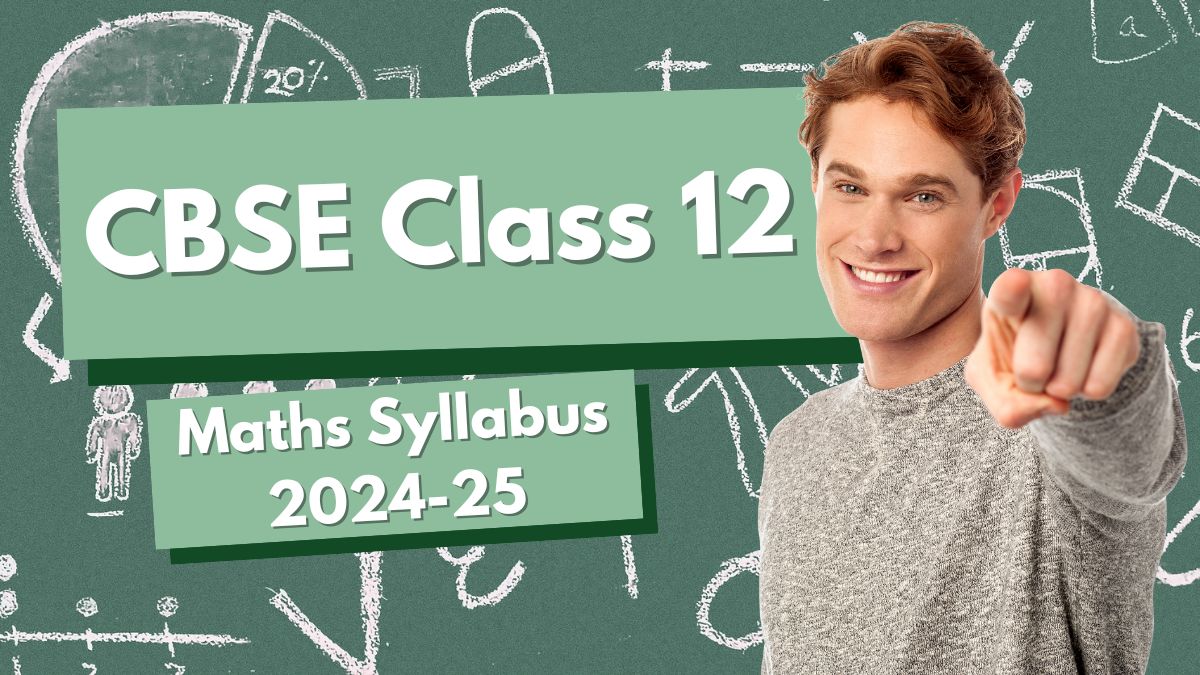The CBSE Class 12 Maths Syllabus 2024-25 is designed to enhance students’ analytical and problem-solving skills while preparing them for competitive exams and higher studies. It covers a range of topics in Algebra, Calculus, Vectors, and Probability, ensuring a strong conceptual foundation.
The syllabus is divided into six units: Relations and Functions, Algebra, Calculus, Vectors and Three-Dimensional Geometry, Linear Programming, and Probability. Among these, Calculus holds the highest weightage, contributing significantly to the overall marks. Key topics include Differentiation, Integration, and Applications of Derivatives, which are crucial for understanding real-world mathematical applications.
Algebra includes concepts such as Matrices and Determinants, essential for solving linear equations. The Vectors and Three-Dimensional Geometry section helps students grasp spatial understanding and geometric representations. Probability introduces advanced probability models like Bayes’ Theorem and Probability Distributions.
The syllabus also emphasizes application-based learning, with real-life examples and problem-solving exercises. The assessment pattern includes theory exams and internal assessments, ensuring a balanced approach to conceptual understanding and practical application.
With a structured approach, the CBSE Class 12 Maths syllabus aims to develop logical reasoning and mathematical proficiency, making it a vital subject for science and commerce students.
CBSE Class 12 Maths Syllabus 2024-25
In the official syllabus PDF, students will find detailed descriptions of each unit, the number of periods assigned to different topics, and the marks distribution, helping them to plan their preparation. This syllabus serves as a roadmap, ensuring that students do not miss out on any important concepts and are well-prepared for every section of the exam. By following it closely, candidates can better focus their learning efforts and boost their chances of scoring high marks.
Unit-wise Syllabus
| Unit No. | Topic | No. of Periods | Marks |
|---|---|---|---|
| I | Relations and Functions | 30 | 08 |
| II | Algebra | 50 | 10 |
| III | Calculus | 80 | 35 |
| IV | Vectors and Three-Dimensional Geometry | 30 | 14 |
| V | Linear Programming | 20 | 05 |
| VI | Probability | 30 | 08 |
| Total | 240 | 80 | |
| Internal Assessment | 20 |
Class 12 Maths Syllabus 2024-25: Unitwise
CBSE Class 12 Maths Syllabus 2024-25 Unit-I: Relations and Functions
- Relations and Functions (15 Periods)
- Types of relations: reflexive, symmetric, transitive, and equivalence relations.
- One-to-one and onto functions.
- Inverse Trigonometric Functions (15 Periods)
- Definition, range, domain, principal value branch.
- Graphs of inverse trigonometric functions.
CBSE Class 12 Maths Syllabus 2024-25 Unit-II: Algebra
- Matrices (25 Periods)
- Concept, notation, order, equality, types of matrices, zero and identity matrix, transpose of a matrix, symmetric and skew symmetric matrices.
- Operations: addition, multiplication, and scalar multiplication.
- Properties: Non-commutativity of multiplication of matrices, existence of non-zero matrices whose product is the zero matrix (restricted to square matrices of order 2).
- Invertible matrices and proof of the uniqueness of the inverse (real entries only).
- Determinants (25 Periods)
- Determinant of a square matrix (up to 3×3 matrices), minors, co-factors, and applications of determinants in finding the area of a triangle.
- Adjoint and inverse of a square matrix.
- Solving systems of linear equations in two or three variables using the inverse of a matrix.
CBSE Class 12 Maths Syllabus 2024-25 Unit-III: Calculus
- Continuity and Differentiability (20 Periods)
- Continuity, differentiability, chain rule, derivative of inverse trigonometric functions.
- Exponential and logarithmic functions, logarithmic differentiation.
- Derivative of implicit and parametric functions, second-order derivatives.
- Applications of Derivatives (10 Periods)
- Rate of change, increasing/decreasing functions, maxima and minima (first and second derivative tests).
- Real-life applications.
- Integrals (20 Periods)
- Integration as the inverse process of differentiation.
- Methods: substitution, partial fractions, and parts.
- Evaluation of integrals (variety of forms listed below):
Types of Integrals ∫ dx/(x² ± a²) ∫ dx/√(x² ± a²) ∫ dx/√(a² – x²) ∫ dx/(ax² + bx + c) ∫ dx/√(ax² + bx + c) ∫ (px + q)/(ax² + bx + c) dx ∫ (px + q)/√(ax² + bx + c) dx ∫ √(a² ± x²) dx ∫ √(x² – a²) dx ∫ √(ax² + bx + c) dx - Fundamental Theorem of Calculus (without proof).
- Properties and evaluation of definite integrals.
- Applications of Integrals (15 Periods)
- Area under curves (lines, circles, parabolas, ellipses).
- Differential Equations (15 Periods)
- Definition, order and degree, general and particular solutions.
- Methods: separation of variables, homogeneous equations, linear differential equations.
CBSE Class 12 Maths Syllabus 2024-25 Unit-IV: Vectors and Three-Dimensional Geometry
- Vectors (15 Periods)
- Vectors and scalars, magnitude, and direction.
- Direction cosines and ratios, types of vectors, position vector, addition, and scalar multiplication.
- Scalar (dot) and vector (cross) product: definition, properties, and applications.
- Three-Dimensional Geometry (15 Periods)
- Direction cosines and ratios of a line.
- Cartesian and vector equations of a line.
- Skew lines, shortest distance, and angle between lines.
Class 12 Maths Syllabus 2024-25 Unit-V: Linear Programming
- Linear Programming (20 Periods)
- Introduction, constraints, objective function, optimization.
- Graphical method for problems in two variables, feasible and infeasible regions and solutions.
CBSE Class 12 Maths Syllabus 2024-25 Unit-VI: Probability
- Probability (30 Periods)
- Conditional probability, multiplication theorem, independent events, total probability.
- Bayes’ theorem, random variables, and their distributions.
- Mean of random variables.
CBSE Class 12 Maths Exam Pattern 2024-25
Here, we have discussed the complete CBSE Class 12 Maths exam pattern 2024-25. Candidates can use this to start their preparation and perform well in the exam. For better understanding, we have provided the table below.
| S. No. | Typology of Questions | Total Marks | % Weightage |
|---|---|---|---|
| 1 | Remembering and Understanding: Recalling, understanding, interpreting | 44 | 55 |
| 2 | Applying: Solve problems using acquired knowledge, techniques | 20 | 25 |
| 3 | Analyzing, Evaluating, Creating: Examining, judging, proposing solutions | 16 | 20 |
| Total | 80 | 100 |
Guidelines
- No chapter-wise weightage. Coverage of all chapters is required.
- Variations may be made for generating different templates, maintaining weightage consistency.
Choice(s)
- No overall choice in the question paper.
- 33% internal choices will be provided in all sections.
CBSE Class 12 Maths Internal Assessment (20 Marks)
Components:
| Assessment Type | Marks |
|---|---|
| Periodic Tests (Best 2 out of 3) | 10 |
| Mathematics Activities | 10 |
| Total | 20 |
Conduct of Periodic Tests:
- Mode: Pen and paper.
- Schedule:
Test Tentative Month Pre Mid-term July-August Mid-Term November Post Mid-Term December-January - The best two tests are considered for final marks, averaged for PT.
Feedback:
- Sharing: Achievement in each test must be shared with students and parents to support learning enhancement.
- Approach: Teachers should provide empathetic, non-judgmental, motivating feedback, using best examples to motivate all learners.
Note: For activities, the NCERT Lab Manual may be referred to.
CBSE Class 12 Maths Syllabus 2024-25 PDF Download
For easy access and offline reference, you can download the complete CBSE Class 12 Maths Syllabus 2024-25 in PDF format. The PDF includes all units, subtopics, periods, and assessment guidelines, ensuring students have comprehensive information to prepare effectively.
CBSE Class 12 Maths Syllabus 2024-25-Click Here To Download PDF
Related Articles:
Maths Class 12 Syllabus 2024-25: FAQs
1. What are the main units covered in the CBSE Class 12 Maths syllabus 2024-25?
The CBSE Class 12 Mathematics syllabus includes the following main units:
- Relations and Functions
- Algebra
- Calculus
- Vectors and Three-Dimensional Geometry
- Linear Programming
- Probability
2. Has CBSE made any changes to the Class 12 Maths syllabus for 2024-25?
CBSE may introduce minor changes in the syllabus each year. Students should refer to the official syllabus provided by CBSE on its website or their school for the latest updates.
3. Which topics have the highest weightage in the CBSE Class 12 Maths exam?
The Calculus unit carries the highest weightage in the exam, followed by Vectors and Three-Dimensional Geometry and Algebra.
4. What is the exam pattern for CBSE Class 12 Maths in 2024-25?
The exam consists of:
- Theory Paper: 80 marks
- Internal Assessment (Assignments, Projects, or Tests): 20 marks
The question paper includes multiple-choice questions, short-answer questions, and long-answer questions.
5. What are the best books for CBSE Class 12 Maths preparation?
- NCERT Mathematics Class 12 (Part 1 & 2) – Highly recommended as per CBSE guidelines.
- RD Sharma Mathematics for Class 12 – This is Useful for additional practice and conceptual clarity.
- RS Aggarwal Senior Secondary School Mathematics – Good for extra problem-solving practice

